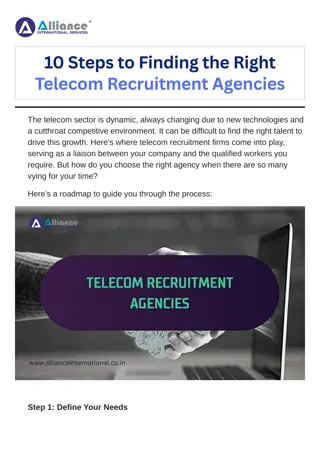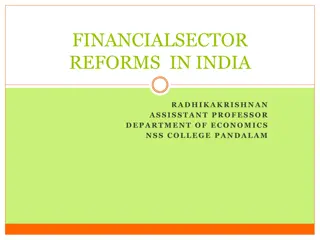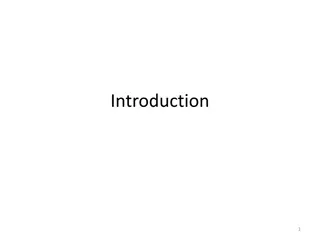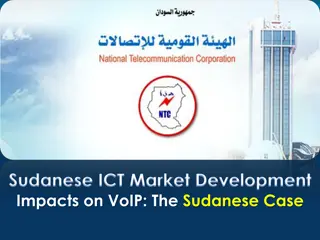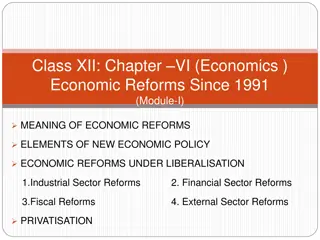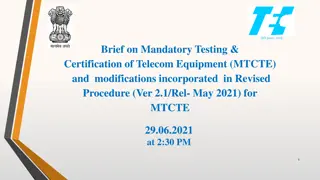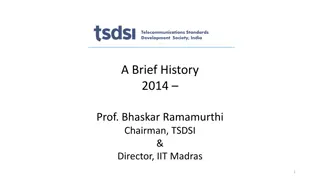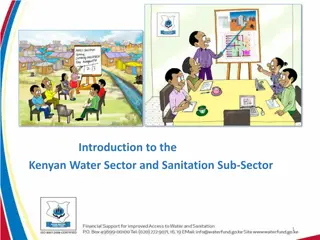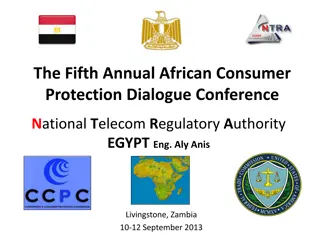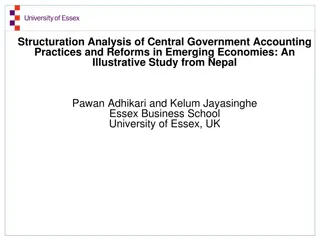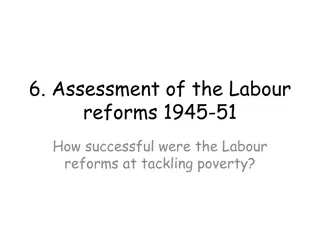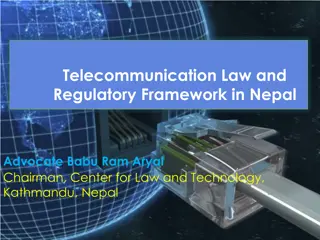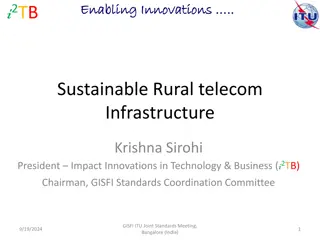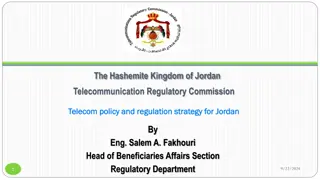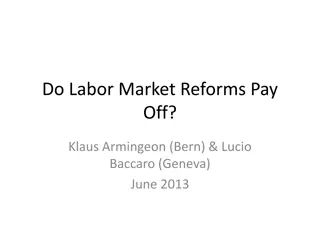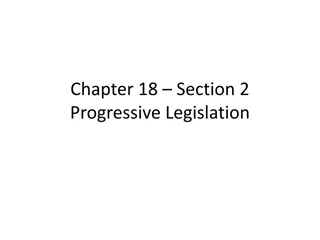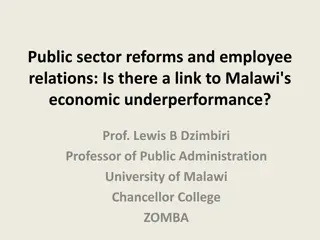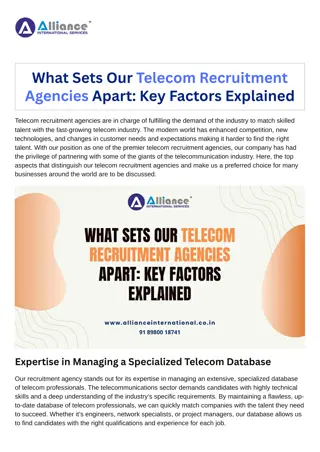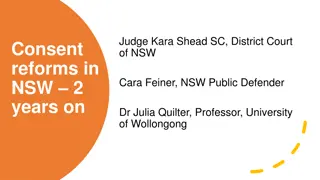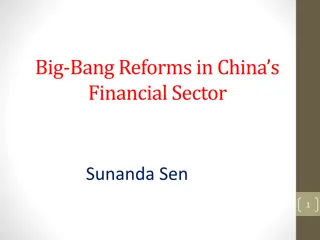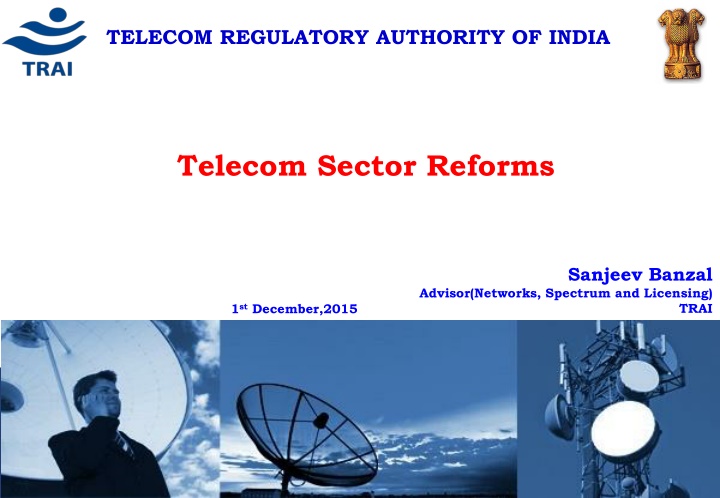
Evolution of Telecom Sector in India: TRAI and Sector Reforms
"Explore the evolution of the Indian telecom sector, from the formation of TRAI to key reforms in licensing and services. Discover growth drivers, sector snapshots, and the eventful journey shaping India's telecommunications landscape."
Download Presentation

Please find below an Image/Link to download the presentation.
The content on the website is provided AS IS for your information and personal use only. It may not be sold, licensed, or shared on other websites without obtaining consent from the author. If you encounter any issues during the download, it is possible that the publisher has removed the file from their server.
You are allowed to download the files provided on this website for personal or commercial use, subject to the condition that they are used lawfully. All files are the property of their respective owners.
The content on the website is provided AS IS for your information and personal use only. It may not be sold, licensed, or shared on other websites without obtaining consent from the author.
E N D
Presentation Transcript
TELECOM REGULATORY AUTHORITY OF INDIA Telecom Sector Reforms Sanjeev Banzal Advisor(Networks, Spectrum and Licensing) TRAI 1st December,2015
India TelecomHighlights Second Highest Number of mobile Subscribers Fastest Growing Market in the World Total Addition of 10 million subs. Per month Telephone Subscribers >1Billion Most of the growth has been in the last decade 1 Xxxxx-xx/Footer
INDIAN TELECOM SECTOR- SNAPSHOT (As on 30th Sept,2015) Number of service areas : 22 Total No. of subscribers : 1,022.61 Million Wireless subscribers : 996.66 Million Wireline subscribers : 25.95 Million Teledensity (overall) : 81 Subscribers availed MNP : 176.39 Million No. of internet subscribers : 340 Million Broadband subscribers : 120.88 Million Gross revenue (for QE Jun-15) : 65030 Crore (Rs) Monthly ARPU : 120 (Rs) 2 Xxxxx-xx/Footer
INDIAN BROADCAST SECTOR- SNAPSHOT Total House holds : 270Million TV Households Registered Channels : (Pvt TV Channels) : 169 Million 826 Pay Channels : 251 FM Radio Stations : 243 Cable Operators : 70000 DTH Operators : 7 Active DTH subscribers: ~40million 3 Xxxxx-xx/Footer
GROWTH DRIVERS Competition Competition Favourable Favourable demographic demographic outlook outlook Political Political stability stability Restriction Restriction removal on removal on FDI FDI DISTINCTION ACHIEVED World's lowest call rates (per second billing World's cheapest mobile handset (USD 6) Sale of 53million mobile phones per quarter Fastest sale of 26.5 million smart phones per quarter. 4 Xxxxx-xx/Footer
Eventful JourneyEvolution 5 Xxxxx-xx/Footer
Contents Evolution of Telecom Sector in India Formation of TRAI (1997) Formation of TDSAT and BSNL (2000) Reforms in Telecom Licensing Access service Licensing Internet Service Licence National Long Distance (NLD) Licence International Long Distance (ILD) Licence National Telecom Policy 2012 Role of TRAI in telecom sector reforms TRAI s key recommendations to the Government Key recent initiatives of the Government 6 Xxxxx-xx/Footer
Licensed Service Area Concept 22 Licensed Service Areas/Circle Jammu & Kashmir Metro : 3 (DL,MU,Kol) A : 5 (AP, Guj, KTK,MH, TN) B : 8 (HR, KER, MP, PB, Raj, UP(E),UP(W),WB) C : 6 (AS, BR, HP,J&K, NE, OR) Himachal Pradesh Punjab UP(W) North Eastern States Haryana DELHI UP(E) Rajasthan Bihar West Bengal Madhya Pradesh Gujarat KOLKATA Orissa Maharashtra MUMBAI Andhra Pradesh Karnataka METRO Circles A Circles Tamil Nadu B Circles Kerala C Circles 4 April 2025 7 Xxxxx-xx/Footer
Characteristics of Circles/LSA Circle is mostly, but not necessarily, co-terminus with the administrative boundaries of the states. Exceptions: Uttar Pradesh(2): UP(E) and UP(W) including Uttarakhand North-East(1): Six NE States except Assam Madhya Pradesh: MP & Chhatisgarh Bihar : Bihar & Jharkhand AP : AP and Telangana WB: WB(except Kolkata), Sikkim and A&N Maharashtra: MH(except Mumbai) and Goa Kerala : Kerala and Lakshadweep Delhi: NCR (Delhi, Faridabad,Gurgaon,Gzb, Noida) Tamilnadu: Earlier TN &Chennai were different; 8 Xxxxx-xx/Footer
Evolution of Indian Telecom Sector Till 1990 s - Government Monopoly 1992 - Private Players permitted in Value Added Services/Cellular NTP 1994- Entry of Private Players in Basic and Cellular Services(duopoly) : availability of telephone on demand, provision of services at reasonable prices, availability of basic telecom services in all the villages, export promotion, FDI attraction and stimulation of domestic investment.
Evolution of Indian Telecom Sector 1994-95 :Licenses were given for cellular mobile services 1997-98: Licenses were given for basic/landline services Entry of Private Sector necessitated independent regulation and appropriate dispute settlement mechanism 1997 - TRAI Act enacted in establishment of TRAI NTP 99 : Highlights: Migration from Fixed to Revenue share regime. Introduction of multipoly from duo-poly Dual charge regime wherein the Cellular Mobile Service Provider (CMSPs) would be required to pay a one-time entry fee and a license fee based on a revenue share Introduced Government operators(BSNL/MTNL) as third operator
Evolution of Indian Telecom Sector 2000- Regulatory Functions and Adjudicatory Functions including dispute settlement separated, amendment of TRAI Act. TDSAT established through 2000 : Govt separated itself from providing services: BSNL formed 2003 : Introduction of Calling Party Pay(CPP) regime : Interconnection Usages Charges(IUC) Regulation : Introduction of Unified Access Service License(UASL) 2004 Broadcasting sector have been brought under TRAI/TDSAT
Evolution of Indian Telecom Sector National Telecom Policy-2012 Highlights : Increase rural teledensity to 70 by the year 2017 and 100 by the year 2020 Achieve 175mn broadband connections by the year 2017 and 600mn by the year 2020 at minimum 2 Mbps download speed and making available higher speeds of at least 100 Mbps on demand Introduce Unified Licensing and delink spectrum from license Provide preference to domestically manufactured telecommunication products Liberalize spectrum by allowing any service in any technology Make available additional 500 MHz spectrum for IMT services by 2020 Ensure mobile number portability and provide free roaming Introduce spectrum sharing and spectrum trading Xxxxx-xx/Footer 12
Growth of Indian Mobile Subscribers and Key Milestones (2000-2015) 13 Xxxxx-xx/Footer
Revenue in the Telecom Sector 233 250 212 Amount in Indian Rupees (INR) 195 200 172 158 152 144 '000 Crores 150 105 86 100 72 50 0 2004-05 2005-06 2006-07 2007-08 2008-09 2009-10 2010-11 2011-12 2012-13 2013-14 Year 14 Xxxxx-xx/Footer
Tariff Vs Teledensity 18 90 16.93 Average tariff per outgoing minute (INR) 16 80 77.27 77.9 76 72.94 70.85 14 70 67.98 Mobile Teledensity 12 60 49.6 10 50 8.55 8 40 33.71 6.38 6 30 4.86 22.78 4 20 3.24 14.62 2.89 2.41 2 10 9.01 1.77 1.15 4.84 0.92 0.76 3.16 0.57 0.51 0.49 0.49 0.48 0.5 0.5 1.24 0.62 0.35 0.19 0.12 0 0 Mar '99Mar '00Mar '01Mar '02Mar '03Mar '04Mar '05Mar '06Mar '07Mar '08Mar '09Mar '10Mar '11Mar '12Mar '13Mar '14Mar '15Jun '15 Year 15 Xxxxx-xx/Footer
Development in other Licenses Internet Service Licence Internet Service was launched on 15th August 1995 through Videsh Sanchar Nigam Limited (VSNL). In November 1998, the sector was opened to Private Operators for providing Internet Services. No Licence Fee and unlimited number of players for delivering Internet service. Annual licence fee at 6% of Adjusted Gross Revenue (AGR) subject to a minimum of Rs.50,000/- for category A and Rs.10,000/- for B service areas. In January 2010, the onetime entry fee was amended to Rs 30 lakh for Category-A & Rs. 15 lakh for Category-B Internet Service License. 16 Xxxxx-xx/Footer
Development in other Licenses National Long Distance (NLD) Licence National Long Distance Services were opened w.e.f. 13th August 2000 without any restriction on the number of operators. As per the original provisions of NLD licence, the combined net worth requirement of the company for NLD licence was Rs 2500 crore and Paid up Capital of Rs 250 crore was required. The entry fee was fixed as Rs 100 crore and the annual licence fee was fixed as 15% of AGR. From 1st January 2006, the licensee was required to pay one-time non refundable Entry Fee of Rs 2.5 crore, an annual licence fee of 6% of AGR. The networth requirement and paid up capital requirement of the company was also reduced to Rs 2.5 crore. License fee in 2013 was increased to 8% of AGR 17 Xxxxx-xx/Footer
Development in other Licenses International Long Distance (ILD) Licence International Long Distance Service opened from 1st April 2002 for private operators. As per the original provisions of ILD licence, the combined Net worth requirement of the company for ILD licence was Rs 25 crore. The entry fee was fixed as Rs 25 crore and the annual licence fee was fixed as 15% of AGR. From 1st January, 2006 these provisions were relaxed and the licensee was required to pay one time Entry Fee of Rs 2.50 crore and an annual licence fee of 6% of AGR. Net worth and Paid up Capital of the company for ILD service licence was reduced to Rs. 2.5 crore. License fee in 2013 was increased to 8% of AGR 18 Xxxxx-xx/Footer
Unified License (UL) One company can have only one UL. There can be authorization for any one or more services. Depending upon the authorization, the scope and jurisdiction of the licence will vary. The allocation of spectrum is delinked from the licence and has to be obtained separately through auctions. License fee made uniform to 8% of AGR 19 Xxxxx-xx/Footer
Authorization For Different Services Under Unified License Sl. No. Authorization Jurisdiction 1 Unified license (All Services) All India jurisdiction 2 Access Service Service Area wise 3. Internet Service : Cat-A All India jurisdiction 4. Internet Service : Cat-B Service Area wise 5. Internet Service : Cat-C Secondary Switching Area wise 6. National Long Distance (NLD) All India jurisdiction 7. International Long Distance (ILD) All India jurisdiction 8. Global Mobile Personal Communication by All India jurisdiction Satellite (GMPCS) Service 9. Public Mobile Radio Trunk (PMRTS) Service Service Area wise 10. Very Small Aperture Terminal (VSAT) Closed All India jurisdiction User Group (CUG) Service 11. INSAT MSS-Reporting (MSS-R) Service All India jurisdiction 12. Resale of International Private Leased Circuit All India jurisdiction (IPLC) Service 20 Xxxxx-xx/Footer
Development in Spectrum Usages Charges Spectrum Usages Charges as %of AGR Amount of spectrum Upto From 01.04.2010 Spectrum For licensees having (MHz) 31.03.2010 obtained administrative and from Auction auctioned spectrum 2014 Upto 2 x 4.4/ 2 x 2.5 2 3 Upto2 x 6.2 3 4 Upto 2 x 8 4 5 Weighted Average of existing slab and holding in 5% slab 5% (for any holding) Upto 2 x 10 4 6 Upto 2 x 12.5 5 7 Upto 2 x 15 6 8 Beyond 2 x 15 9 21 Xxxxx-xx/Footer
Role of TRAI in Telecom Sector Reforms 22 Xxxxx-xx/Footer
Regulatory Framework in India Agencies involved Licensor:- Granting of Licenses TRAI :- Recommendations and Regulations HC/TDSAT :- Appellate & Adjudication Supreme Court :- Final Appellate Authority 23 Xxxxx-xx/Footer
Regulators of the Sectors Cable & TRAI Telecom Broadcasting Ministry of Information & Broadcasting Ministry of Communications & IT
ORGANISATION CHART Chairman Member (Whole-time) Member (Whole-time) Member (Part-Time) Member (Part-Time) TRAI Secretary 25 25 Xxxxx-xx/Footer
TRAIs Areas of Concern Consumer Protection Qualityof Service Affordable Tariff Interconnection Regulations, Directions, Orders Recommendations
TRAI - MISSION To ensure that the interests of consumers are protected and nurture conditions for growth of, telecommunications broadcasting and cable services in a manner and at a pace which will enable India to play a leading role in the emerging global information society. To achieve above, the Authority follows a consultation process in the discharge of its functions: TRAI interacts with various stakeholders Holds Open House Meetings for having interactive sessions with stakeholders and experts The participative and explanatory process adopted by TRAI leads to transparency in policy making and has received wide acclaimation. 27
TRAI - GOALS AND OBJECTIVES Providing a regulatory regime that facilitates achievements of the objective of New Telecom Policy Increase in the tele-density and access to Telecommunication at affordable price. Transparency in decision making by affording an opportunity to all stakeholders Adoption of emerging technologies within the framework of a technology neutral policy. 28 Xxxxx-xx/Footer
TRAI - GOALS AND OBJECTIVES Promoting level playing field and competition amongst Service Providers Making available telecom services which in terms of range, price & quality are comparable to the best in the world. Rebalancing tariffs to achieve objectives of affordability Protecting the interest of consumers Monitoring the quality of service
TRAIs Power & Functions Recommendatory Licensing related issues Measures to facilitate competition and growth Issues related to increase n efficiency of telecom operations Efficient management of available Spectrum Regulatory Functions Interconnection Tariff Fixation of the Services Quality of Service Issue orders/Directions to the Service Providers on matters relating to its Regulatory Functions
Regulatory Approach Focus on optimization of network buildup and efficiency of operation Nurturing of competitive market scenario Well timed interventions and forbearance of tariff Initiatives for Infrastructure sharing, VoIP, MVNO, 3G & 4G Bridging the DigitalDivide Broadband for Inclusive Growth Restructuring of Cable TV, Digitalisation, Promotion of CAS, DTH, FM Radio etc 31 Xxxxx-xx/Footer
Regulatory Issues addressed USO Comprehensive USO Policy in place Issues addressed through regulations and directives; Interconnection One of the few countries to publish RIO A comprehensive IUC regime too is in place Telecom Tariff Order & amendments; Tariffs De-regulation of tariffs, starting with cellular tariffs Monitoring of tariffs for predation Based on TRAI recommendations, open competition has been introduced in all sectors including unified access. Licensing Regulatory Internet Telephony introduced Tool End User Quality of Service regulation, Quality of Service Box Publicly available customer survey, MNP Accounting separation, RIO by service providers with Significant Market Power, Merger issues MNP Competition Broadband Broadband Policy 2004 issued by Govt. Cable & Broadcasting Protection of consumers Interest
Tariff Issues Consumers Interest Disclosure of full details of tariffs Explicit consent of customers for VAS Full talk time on Top Ups, except administrative fee and applicable taxes. No migration Charge Protection against hike in tariffs key tariff information in vernacular language at all the retail outlets No change in mobile number when subscriber change tariff plans or move from prepaid to postpaid & vice versa and when moves from one service area to another. Ceiling for roaming tariffs.
Major Recommendations of TRAI for sectoral reforms Introduction of competition in National Long Distance Service and International Long Distance Service Intra-Circle merger and acquisition guidelines Infrastructure sharing Mobile Number Portability/Full Number Portability Promotion of competition in IPLC Resale in IPLC Licensing policy for Access Service Provisions Introduction of Conditional Access System Auction for spectrum
Latest Recommendations Spectrum auctions:2012,2013,2014 & 2015 Broadband penetration quickly Spectrum trading and sharing Single number based Integrated emergency and communication response system(IECRS) Priority call routing for the persons involved in the rescue and relief operations during disasters Telecom planning for NE States, ANI and Lakshadweep islands Introduction of Virtual Network Operators(VNOs) 35 Xxxxx-xx/Footer
Latest Regulations Mobile Number Portability --Pan India Portability Telecommunications Commercial Communications Customer Preference Regulations(Do not call registry) Compensation on cal drops Financial disincentives for operators for failing to maintain quality of services, wrongful rejection of MNP request 36 Xxxxx-xx/Footer
Recent Government Initiatives Approved the rules for spectrum trading that will allow telecom companies to buy and sell rights to unused spectrum among themselves. Approved the guidelines on spectrum sharing, aimed to improve spectral efficiency and quality of service Several initiatives to promote manufacturing in the country, Preferential market access to promote Make in India Government plans to roll out free high-speed wi-fi in 2,500 cities and towns across the country over the next three years. 37 Xxxxx-xx/Footer
THANK YOU Sanjeev Banzal Advisor(Networks, Spectrum and Licensing) TRAI Email: sbanzal@gmail.com www.trai.gov.in 38 Xxxxx-xx/Footer
Eligibility conditions under Unified Licensing Sl No. Service Minimum Equity (Rs. Cr.) 25 Minimum Networth (Rs. Cr.) 25 1 UL(All services) Service Authorisation wise requirements 1 Access Service (Telecom Circle / Metro Area) 2.5 2.5 2 NLD (National Area) 2.5 2.5 3 ILD (National Area) 2.5 2.5 4 GMPCS (National Area) 2.5 2.5 5 Resale IPLC (National Area) 2.5 2.5 6 Other Authorisations NIL NIL 39 Xxxxx-xx/Footer
Entry fee under Unified Licensing Sl No. Service Entry Fee (Rs. In Crore) 1 UL(All services) 15 Service Authorisation wise requirements Access Service (Telecom Circle / Metro 1 1 0.5 for NE/ J&K Area) 2 3 4 5 6 7 8 9 10 11 NLD (National Area) ILD (National Area) VSAT (National Area) PMRTS (Telecom circle/Metro) GMPCS (National Area) INSAT MSS-R (National Area) ISP "A" (National Area) ISP "B" (Telecom circle/Metro Area) ISP "C" (SSA) Resale IPLC(National Area) 2.5 2.5 0.3 0.005 1 0.3 0.3 0.02 0.002 1 40 Xxxxx-xx/Footer


